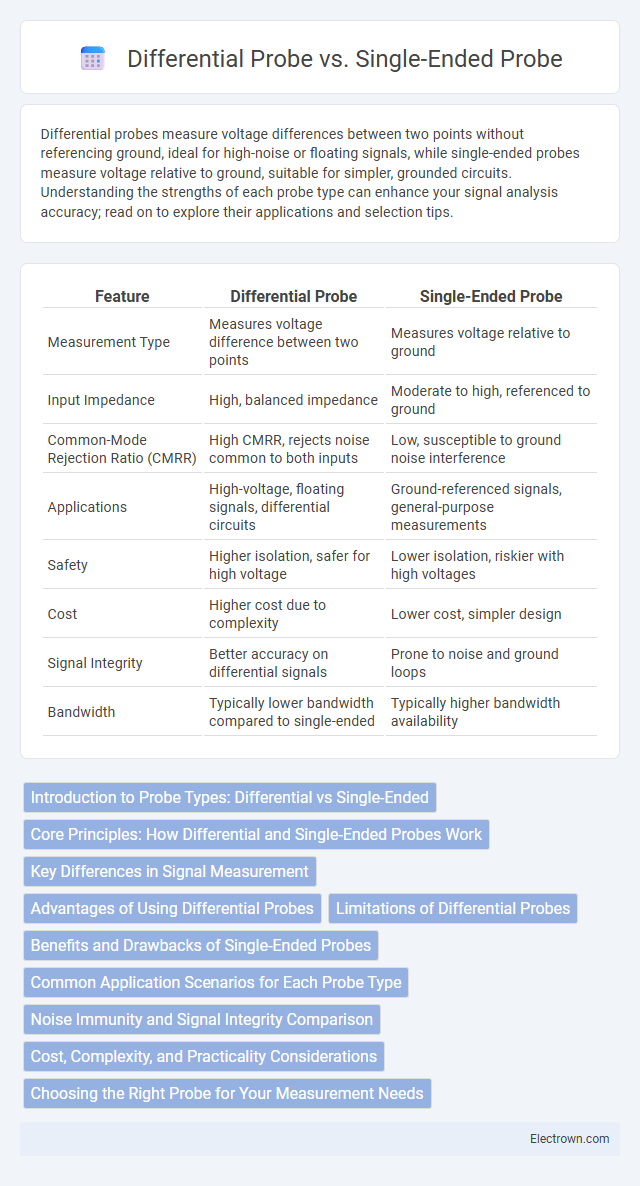Differential probes measure voltage differences between two points without referencing ground, ideal for high-noise or floating signals, while single-ended probes measure voltage relative to ground, suitable for simpler, grounded circuits. Understanding the strengths of each probe type can enhance your signal analysis accuracy; read on to explore their applications and selection tips.
Table of Comparison
| Feature | Differential Probe | Single-Ended Probe |
|---|---|---|
| Measurement Type | Measures voltage difference between two points | Measures voltage relative to ground |
| Input Impedance | High, balanced impedance | Moderate to high, referenced to ground |
| Common-Mode Rejection Ratio (CMRR) | High CMRR, rejects noise common to both inputs | Low, susceptible to ground noise interference |
| Applications | High-voltage, floating signals, differential circuits | Ground-referenced signals, general-purpose measurements |
| Safety | Higher isolation, safer for high voltage | Lower isolation, riskier with high voltages |
| Cost | Higher cost due to complexity | Lower cost, simpler design |
| Signal Integrity | Better accuracy on differential signals | Prone to noise and ground loops |
| Bandwidth | Typically lower bandwidth compared to single-ended | Typically higher bandwidth availability |
Introduction to Probe Types: Differential vs Single-Ended
Differential probes measure the voltage difference between two points, making them ideal for testing signals in noisy environments or circuits with ground potential differences. Single-ended probes measure the voltage between a test point and a common ground, offering simplicity and cost-effectiveness for standard signal analysis. Understanding the fundamental operational differences helps in selecting the appropriate probe for accurate signal acquisition and minimizing measurement errors.
Core Principles: How Differential and Single-Ended Probes Work
Differential probes measure the voltage difference between two input points, rejecting common-mode signals and noise by using two matched input leads and an internal amplifier to provide accurate differential voltage readings. Single-ended probes measure the voltage between one input point and a common ground reference, making them susceptible to noise and ground loop interference when the reference ground is not stable. Differential probes are essential for applications involving floating signals or high common-mode voltages, while single-ended probes are simpler and suited for low-noise, grounded systems.
Key Differences in Signal Measurement
Differential probes measure the voltage difference between two points without referencing ground, providing high noise immunity and accurate signal capture in noisy environments or floating circuits. Single-ended probes measure the voltage between one signal point and ground, making them suitable for simpler, low-noise applications but susceptible to ground loop interference. You should choose a differential probe for precise, high-frequency measurements where common-mode noise rejection is critical.
Advantages of Using Differential Probes
Differential probes offer superior noise rejection by measuring voltage differences between two points, eliminating common-mode signals that single-ended probes cannot filter effectively. They provide enhanced accuracy in high-speed and high-voltage measurements, protecting test equipment from potential damage. Differential probes are essential in analyzing complex circuits like power electronics and high-frequency communication systems, ensuring precise and reliable signal capture.
Limitations of Differential Probes
Differential probes have limitations including a higher cost and more complex calibration compared to single-ended probes, which can impact budget and setup time. Their bandwidth is often lower, and their input capacitance can affect high-frequency signal accuracy, restricting performance in certain applications. You may also encounter size constraints and susceptibility to common-mode voltage limits that reduce measurement flexibility.
Benefits and Drawbacks of Single-Ended Probes
Single-ended probes are widely used for their simplicity and cost-effectiveness in measuring signals referenced to ground. They offer high sensitivity and ease of use but are limited by susceptibility to ground noise and common-mode interference, making them less ideal for differential signal measurements. Choosing the right probe depends on your specific application and the signal environment, as single-ended probes may introduce inaccuracies in noisy or high-frequency systems.
Common Application Scenarios for Each Probe Type
Differential probes excel in measuring signals in high-noise environments and high-voltage applications, such as power electronics testing and automotive diagnostics, where accurate differential voltage measurement is critical. Single-ended probes are commonly used in general-purpose signal analysis, low-voltage digital circuits, and troubleshooting standard electronic devices, making them ideal for straightforward signal measurement tasks. Your choice depends on the signal environment and voltage levels; differential probes reduce noise interference in complex circuits, while single-ended probes offer simplicity for basic measurements.
Noise Immunity and Signal Integrity Comparison
Differential probes offer superior noise immunity compared to single-ended probes by measuring the voltage difference between two points, effectively rejecting common-mode noise and enhancing signal integrity in noisy environments. Single-ended probes reference a signal to ground, making them more susceptible to ground loops and electromagnetic interference that can degrade measurement accuracy. Choosing a differential probe can significantly improve Your signal analysis accuracy in high-frequency or precision applications where noise reduction is critical.
Cost, Complexity, and Practicality Considerations
Differential probes generally incur higher costs than single-ended probes due to their complex internal circuitry and additional components required for noise rejection and common-mode voltage handling. Their complexity demands more expertise for accurate signal interpretation and calibration, making them less practical for simple or budget-conscious measurements. In contrast, single-ended probes offer affordable, straightforward operation suitable for general-purpose use but may struggle with noise in high-precision or high-speed environments.
Choosing the Right Probe for Your Measurement Needs
Differential probes provide accurate measurements of small signals in noisy environments by rejecting common-mode noise, making them ideal for high-speed, high-precision applications such as power electronics and communication systems. Single-ended probes are simpler and cost-effective, best suited for measuring signals referenced to a common ground with lower frequency and lower noise sensitivity. Selecting the right probe depends on factors like signal amplitude, bandwidth requirements, noise environment, and the need for isolation between measurement points.
differential probe vs single-ended probe Infographic

 electrown.com
electrown.com